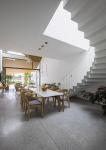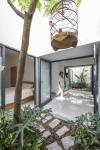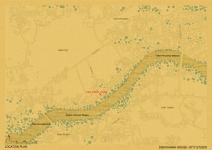The urbanization is strongly developing from the city to the rural areas in Vietnam. The city tube houses have began to appear more and more densely in rural areas, disrupting the peaceful and poetic image of the village. Dien Khanh house tries to retain the traditional familiarity that is gradually fading away of rural houses, in order to create a fresh living environment, close to nature and the surrounding environment, but also satisfy modern life and contemporary social development.
From the birdview, the project is both strange and familiar with the combination of undulating tile roofs in harmony with the charming scenery of mountains and rivers in the land of Dien Khanh.
Because the project is located in the central coastal area, where often subjected to harsh rainstorms, the shape and materials are also carefully studied to suit the local terracotta climate. The large concrete sloping roof extends from the first floor to the lower ground floor of the building plus the wide porch to prevent the living room from the sun in the summer and the rain in the winter. The roof shape of Duyen Khanh house is suitable for storm protection, the sloping roof allows the wind to slide on the building to limit the damage of storm attacks. The red tile covering on the concrete roof surface has the function of both protection and heat resistance for the roof.
Simultaneously with the use of such roof form, it creates familiarity when approaching the building.
The setback is large enough for the front yard, the two sides of the fence are planted with familiar rows of areca combined with green trees. The yard is tiled with Chinese bricks, both creating a connection with the roof tile and reminiscent of the familiar courtyard image of traditional Vietnamese houses
The design solution of opening and closing space, leading, surprising the viewer. From the yard, the view gradually changes as we enter the house, the space expands in height, the living room is connected to the 1st floor with a large atrium space, and the space begins to gradually closing when the ceiling height of the dining room decreases, then the space narrows when passing through the connecting corridor to the back of the house. From that corridor, it expands and connects the kitchen space, skylight and parents' bedroom.
The living and relaxing spaces are divided by the atrium and the skylight between the house. Through these spaces, natural light and wind are led into the building naturally, creating light, ventilation and coolness for the building. The parents' bedroom is separated from the living space and the kitchen by a atrium space with a small garden in the middle of the house. Rooms for 2 adults, because it is rarely used, it is arranged on the 1st floor, also connected to each other through this atrium.
The bedrooms are arranged separately but still connect together and connect with nature.
Stair is the highlight of the house. Curved stairs combined with the atrium at the broken corner of the land, creating a sense of neatness and breaking the broken corner of the building. Finishing materials for the stair and the building are also considered. Terrazzo is used as a familiar material used by our forefathers in the past and also limits the disadvantages of the land and creates familiarity and close.
The interior design aims the simplicity, modern conveniences of contemporary life. The use of white pain and light wood creates a spacious and bright interior space. Traditional elements are cleverly incorporated into the interior space, such as the living room wooden sofa, the patio seat commonly found in traditional Vietnamese housing spaces.
2020
2020
• Project location: Dien Phu commune, Dien Khanh district, Khanh Hoa province, Viet Nam.
• Site area: 200sqm (5mX 40m)
• Gross Built Area: 140sqm (5mX 26m)
• Lead Architects: Le Viet Hoi
• Design Team: Dang Thanh Bao; Nguyen Van Duc
• Engineering & Construction: Nguyen Ngoc Thien
• Landscape: 6717studio
• Photo credits: Hiroyuki Oki





















